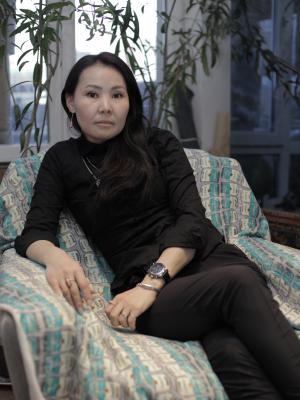
Nomin Bold | Болдын Номин
Nomin Bold (*1982 in Ulaanbaatar, Mongolia) is an important female painter who plays a significant role in the contemporary Mongolian art scene. As a member of a new generation of artists, she focuses on the Mongol Zurag, literally translated as "Mongolian image". She graduated from the Mongol Zurag class at the College of Fine Arts in Ulaanbaatar, where she developed her unique artistic voice. Known for her fusion of Buddhist symbolism and modern elements, her works encourage reflection on cultural identity in the modern world. Using delicate colors, detailed drawings and solitary female figures in traditional or modern dress, she creates intriguing compositions.
Nomin's work has been shown internationally at prestigious exhibitions such as documenta 14, 2017 and the Asia Pacific Triennial of Contemporary Art, 2015. Her painting, influenced by the Buddhist Thangkha technique, captivates with a mysterious aura and profound questions.
Mongol zurag is a style of painting in Mongolian art. Developed in the early 20th century, zurag is characterised by the depiction of secular, nationalist themes in a traditional mineral-paint–on–cotton medium similar to Tibetan thangka. It is thus distinguished from both traditional Buddhist fine art and the socialist realism favoured during the Mongolian People's Republic.
The style was pioneered in the aftermath of the 1921 Revolution by artists such as Balduugiin Sharav, whose One Day in Mongolia remains one of the most celebrated works of Mongolian art. Zurag paintings featuring scenes from everyday life, in both contemporary collective farm and traditional pastoral nomadic settings, became popular in the 1950s and 1960s. Historical depictions of the 1921 Revolution as well as earlier national figures were also popular, but overtly religious themes were discouraged by the state. Since the establishment of democracy in 1992 there has been a resurgence of interest in the style. Recent zurag paintings have featured nationalistic scenes drawn from the Secret History of the Mongols and the life of Genghis Khan, as well overtly religious imagery inspired by pre-Buddhist shamanism. They have also become more symbolic and less strictly representational.
Throughout its history zurag has encompassed a diverse range of visual styles. Flat, brightly coloured shading in the Buddhist tradition is used alongside European-style realism and geometric perspective. Some zurag artists co-opted older Buddhist iconographic conventions for purely secular topics.
